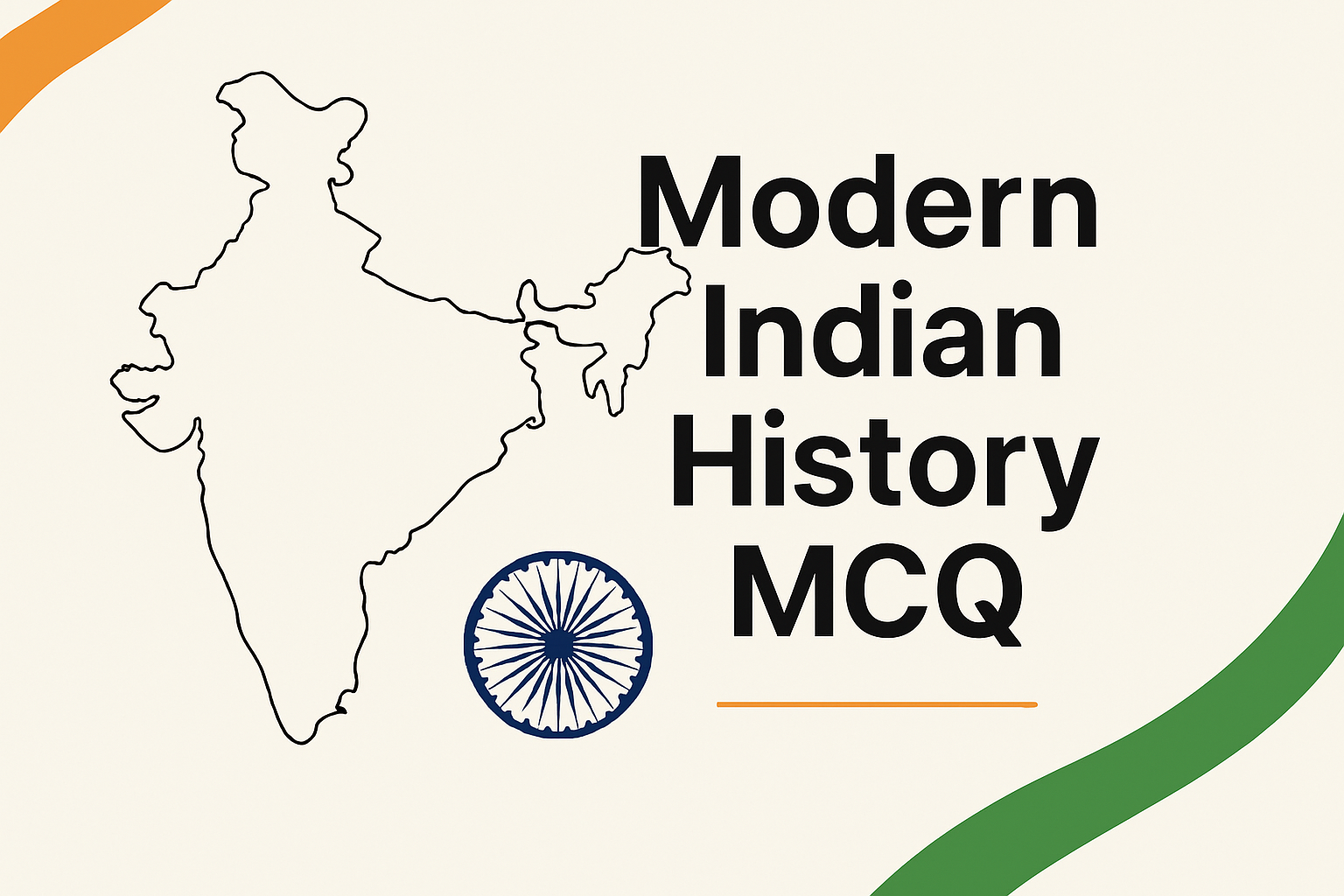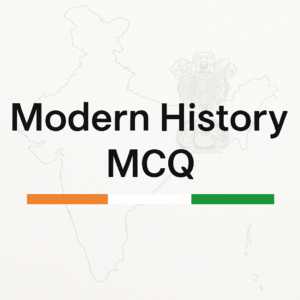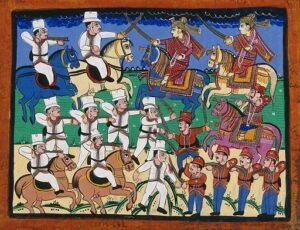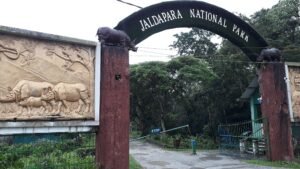Speed up your exam preparation with this Modern Indian History MCQ sprint, designed for quick recall and accuracy. This focused capsule highlights key Acts, national movements, institutions, and leaders, mirroring the one-liner MCQs commonly asked in competitive quizzes and drill sessions. Covering the entire span from colonial rule to the early Republic, this high-yield Modern Indian History MCQ set is perfect for consolidating important facts before mock tests.
Modern Indian History MCQs – Practice Set of 60
- Pitt’s India Act (1784) created which supervisory body in Britain?
A) Court of Directors
B) Board of Control
C) Privy Council
D) India OfficeShow Answer
Answer: B) Board of Control
- Which Act ended the Company’s monopoly over Indian trade except tea and trade with China?
A) Regulating Act, 1773
B) Charter Act, 1813
C) Charter Act, 1833
D) Pitt’s India Act, 1784Show Answer
Answer: B) Charter Act, 1813
- Who became the first Governor-General of India under the Charter Act of 1833?
A) Lord Cornwallis
B) Lord William Bentinck
C) Lord Wellesley
D) Lord DalhousieShow Answer
Answer: B) Lord William Bentinck
- Open competition for the Indian Civil Services was introduced by:
A) Charter Act, 1853
B) Indian Councils Act, 1861
C) Government of India Act, 1858
D) Charter Act, 1833Show Answer
Answer: A) Charter Act, 1853
- Who is regarded as the “Father of the Indian Civil Services”?
A) Lord Hastings
B) Lord Cornwallis
C) Lord Curzon
D) Lord RiponShow Answer
Answer: B) Lord Cornwallis
- The Mahalwari system of revenue settlement was introduced primarily in:
A) Bengal
B) Madras Presidency
C) North-Western Provinces
D) Bombay PresidencyShow Answer
Answer: C) North-Western Provinces
- The Indigo Commission to inquire into planter–ryot disputes was appointed in:
A) 1857
B) 1860
C) 1865
D) 1870Show Answer
Answer: B) 1860
- Which is called the “Magna Carta of English Education in India”?
A) Wood’s Despatch, 1854
B) Hunter Commission, 1882
C) Raleigh Commission, 1902
D) Saddler Commission, 1917–19Show Answer
Answer: A) Wood’s Despatch, 1854
- The Hunter Commission (1882) on education was appointed by:
A) Lord Lytton
B) Lord Ripon
C) Lord Curzon
D) Lord LansdowneShow Answer
Answer: B) Lord Ripon
- The Indian Universities Act (1904) was passed during the viceroyalty of:
A) Lord Curzon
B) Lord Minto II
C) Lord Hardinge II
D) Lord ChelmsfordShow Answer
Answer: A) Lord Curzon
- The Age of Consent Act, which raised the age for girls, was enacted in:
A) 1881
B) 1891
C) 1901
D) 1911Show Answer
Answer: B) 1891
- The first Factory Act in India (regulating hours of work for women and children) came in:
A) 1854
B) 1861
C) 1881
D) 1891Show Answer
Answer: C) 1881
- Who is known as the “Father of Local Self-Government” in India?
A) Lord Ripon
B) Lord Curzon
C) Lord Lytton
D) Lord MayoShow Answer
Answer: A) Lord Ripon
- The Vernacular Press Act (1878) was repealed by:
A) Lord Canning
B) Lord Ripon
C) Lord Dufferin
D) Lord Hardinge IIShow Answer
Answer: B) Lord Ripon
- The Indian Association (1876), a pre-Congress political body, was founded by:
A) Dadabhai Naoroji
B) Surendranath Banerjee & Ananda Mohan Bose
C) Pherozeshah Mehta
D) Gopal Krishna GokhaleShow Answer
Answer: B) Surendranath Banerjee & Ananda Mohan Bose
- The Poona Sarvajanik Sabha was established (1867) at:
A) Calcutta
B) Poona
C) Bombay
D) AllahabadShow Answer
Answer: B) Poona
- The Muhammadan Anglo-Oriental (MAO) College at Aligarh was founded by Sir Syed Ahmad Khan in:
A) 1867
B) 1875
C) 1885
D) 1890Show Answer
Answer: B) 1875
- The Brahmo Samaj was founded in 1828 by:
A) Ishwar Chandra Vidyasagar
B) Raja Rammohan Roy
C) Keshab Chandra Sen
D) Debendranath TagoreShow Answer
Answer: B) Raja Rammohan Roy
- The Prarthana Samaj (1867) was founded in:
A) Calcutta
B) Bombay
C) Lahore
D) MadrasShow Answer
Answer: B) Bombay
- The Ramakrishna Mission (1897) was founded by:
A) Swami Vivekananda
B) Ramakrishna Paramahamsa
C) Swami Dayanand
D) Aurobindo GhoshShow Answer
Answer: A) Swami Vivekananda
- The Servants of India Society (1905) was established by:
A) Bal Gangadhar Tilak
B) Gopal Krishna Gokhale
C) Lala Lajpat Rai
D) Bipin Chandra PalShow Answer
Answer: B) Gopal Krishna Gokhale
- The All-India Muslim League was founded at:
A) Lahore, 1907
B) Dhaka, 1906
C) Aligarh, 1905
D) Lucknow, 1916Show Answer
Answer: B) Dhaka, 1906
- Gandhi’s first satyagraha in India (Champaran) related to:
A) Indigo peasants
B) Mill workers’ wages
C) Salt law
D) Partition of BengalShow Answer
Answer: A) Indigo peasants
- The Kheda Satyagraha (1918) was primarily for the remission of:
A) Salt tax
B) Land revenue
C) Forest cess
D) Textile dutiesShow Answer
Answer: B) Land revenue
- The Ahmedabad Mill Strike (1918) was led by Gandhi against:
A) Reduction of wages
B) Dismissal of workers
C) Excessive working hours
D) Factory closuresShow Answer
Answer: A) Reduction of wages
- The Khilafat Movement (1919–24) was led chiefly by:
A) Ali brothers
B) Nehru and Patel
C) Tilak and Besant
D) Bose and AzadShow Answer
Answer: A) Ali brothers
- The All India Trade Union Congress (AITUC) was founded in:
A) 1917
B) 1920
C) 1923
D) 1925Show Answer
Answer: B) 1920
- Which journal was closely associated with Mahatma Gandhi?
A) Young India
B) Kesari
C) New India
D) Bande MataramShow Answer
Answer: A) Young India
- The Hindustan Socialist Republican Association (HSRA) was formed in:
A) 1922
B) 1924
C) 1928
D) 1931Show Answer
Answer: C) 1928
- The Kakori Conspiracy (train robbery) took place in:
A) 1921
B) 1923
C) 1925
D) 1927Show Answer
Answer: C) 1925
- The Chittagong Armoury Raid (1930) was led by:
A) Surya Sen
B) Batukeshwar Dutt
C) Ram Prasad Bismil
D) Khudiram BoseShow Answer
Answer: A) Surya Sen
- Approximately how many miles did Gandhi’s Dandi March cover?
A) 120 miles
B) 180 miles
C) 240 miles
D) 300 milesShow Answer
Answer: C) 240 miles
- The Karachi Session (1931) is noted for a resolution on:
A) Separate electorates
B) Fundamental Rights and Economic Policy
C) Dominion Status
D) Federal CourtShow Answer
Answer: B) Fundamental Rights and Economic Policy
- The Wardha Scheme (1937) of Basic Education was associated with:
A) Zakir Husain Committee
B) Hunter Commission
C) Saddler Commission
D) Mudaliar CommissionShow Answer
Answer: A) Zakir Husain Committee
- Congress ministries in several provinces resigned in 1939 primarily due to:
A) Communal Award
B) Outbreak of World War II and war policy
C) Failure of Round Table Conferences
D) August Offer termsShow Answer
Answer: B) Outbreak of World War II and war policy
- The Forward Bloc was formed by Subhas Chandra Bose in:
A) 1936
B) 1937
C) 1938
D) 1939Show Answer
Answer: D) 1939
- The Indian National Army (INA) was reorganized in 1943 by:
A) Mohan Singh
B) Subhas Chandra Bose
C) Rash Behari Bose
D) Captain Lakshmi SahgalShow Answer
Answer: B) Subhas Chandra Bose
- The Provisional Government of Azad Hind was proclaimed at:
A) Rangoon, 1942
B) Singapore, 1943
C) Imphal, 1944
D) Tokyo, 1945Show Answer
Answer: B) Singapore, 1943
- The slogan “Do or Die” is associated with:
A) Non-Cooperation Movement
B) Civil Disobedience Movement
C) Quit India Movement
D) Khilafat MovementShow Answer
Answer: C) Quit India Movement
- “Give me blood, and I shall give you freedom” is attributed to:
A) Bal Gangadhar Tilak
B) Subhas Chandra Bose
C) Lala Lajpat Rai
D) Bhagat SinghShow Answer
Answer: B) Subhas Chandra Bose
- The main deadlock at the Shimla Conference (1945) related to:
A) Federal finance
B) Representation of Muslims in the Executive Council
C) Princely states’ accession
D) Boundary demarcationShow Answer
Answer: B) Representation of Muslims in the Executive Council
- Under the Cabinet Mission Plan, which of the following was proposed?
A) Immediate Dominion Status
B) Grouping of provinces into Sections A, B, C
C) Unitary Centre with residuary powers
D) Partition into three dominionsShow Answer
Answer: B) Grouping of provinces into Sections A, B, C
- The Government of India Act, 1935 led to the establishment (1937) of the:
A) Federal Court
B) Supreme Court of India
C) Privy Council (India)
D) Central Vigilance CommissionShow Answer
Answer: A) Federal Court
- The Royal Indian Navy uprising (Feb 1946) began at:
A) HMIS Talwar, Bombay
B) HMIS Himalaya, Karachi
C) Cochin Dockyard
D) Visakhapatnam YardShow Answer
Answer: A) HMIS Talwar, Bombay
- In the Interim Government (1946), the Finance portfolio was held by:
A) Jawaharlal Nehru
B) Vallabhbhai Patel
C) Liaquat Ali Khan
D) C. RajagopalachariShow Answer
Answer: C) Liaquat Ali Khan
- The Constituent Assembly of India first met on:
A) 26 January 1950
B) 9 December 1946
C) 26 November 1949
D) 15 August 1947Show Answer
Answer: B) 9 December 1946
- The temporary President of the Constituent Assembly was:
A) Dr. Rajendra Prasad
B) Dr. Sachchidananda Sinha
C) B. R. Ambedkar
D) H. C. MookherjeeShow Answer
Answer: B) Dr. Sachchidananda Sinha
- The Objective Resolution in the Constituent Assembly was moved by:
A) B. R. Ambedkar
B) Jawaharlal Nehru
C) Sardar Patel
D) C. RajagopalachariShow Answer
Answer: B) Jawaharlal Nehru
- The Radcliffe Line, demarcating India–Pakistan boundaries, was drawn by:
A) Sir Cyril Radcliffe
B) Sir Stafford Cripps
C) Lord Mountbatten
D) Sir Claude AuchinleckShow Answer
Answer: A) Sir Cyril Radcliffe
- Operation Polo (September 1948) led to the integration of:
A) Junagadh
B) Hyderabad
C) Kashmir
D) TravancoreShow Answer
Answer: B) Hyderabad
- The Instrument of Accession of Jammu and Kashmir was signed in:
A) June 1947
B) October 1947
C) January 1948
D) May 1948Show Answer
Answer: B) October 1947
- India’s first general elections were held during:
A) 1947–48
B) 1949–50
C) 1951–52
D) 1953–54Show Answer
Answer: C) 1951–52
- The Planning Commission was established in:
A) 1948
B) 1949
C) 1950
D) 1951Show Answer
Answer: C) 1950
- The Indian Councils Act of 1861 is associated with introducing:
A) Dyarchy in provinces
B) Portfolio system and legislative councils
C) Separate electorates
D) Federal courtShow Answer
Answer: B) Portfolio system and legislative councils
- The Raleigh Commission (1902) inquired into:
A) Primary education
B) University education
C) Female education
D) Technical educationShow Answer
Answer: B) University education
- The Saddler Commission (1917–19) is linked with reforms in:
A) Bombay University
B) Calcutta University
C) Madras University
D) Allahabad UniversityShow Answer
Answer: B) Calcutta University
- The Indian National Congress’s “Poorna Swaraj Day” was first observed on:
A) 26 January 1930
B) 15 August 1930
C) 26 January 1931
D) 2 October 1929Show Answer
Answer: A) 26 January 1930
- The famous Komagata Maru incident (regarding Indian migrants) occurred in:
A) 1912
B) 1914
C) 1916
D) 1918Show Answer
Answer: B) 1914
- The Ghadar Party was founded in 1913 at:
A) London
B) Berlin
C) San Francisco
D) SingaporeShow Answer
Answer: C) San Francisco
- Who is often called the “Grand Old Man of India”?
A) Surendranath Banerjee
B) Dadabhai Naoroji
C) Gopal Krishna Gokhale
D) Mahadev Govind RanadeShow Answer
Answer: B) Dadabhai Naoroji
This 60 Modern Indian History MCQ practice set gives you a quick way to revise key Acts, movements, leaders, and institutions. Keep practicing regularly, and you’ll boost both your speed and accuracy in competitive exams.
Modern History MCQs: 50 Important quiz for Competitive Exams
Indian History MCQs : 30 Important Questions for Exams
100 Assam History MCQs for Competitive Exams Part 1







